
- •6 Bonhill Street London ec2a4pu United Kingdom
- •1. Sociology-Methodology. 2. Social sciences-Methodology.
- •Introduction: The Nature of Science
- •Theoretical Concepts: The Building Blocks of Theory
- •Theoretical Statements Relating Two Variables
- •Identifying Assumptions Forms of Hypotheses Causal Direction
- •Living in another country and adapting successfully to its culture rather than remaining in an American ghetto
- •Introduction
- •Variables Versus Nonvariables
- •Interviewer: Code to the nearest half hour, e.G., 0, 0.5,1.0,1.5, to maximum of 24 hours.
- •Identifying Dimensions of a Construct
- •Viewers viewers
- •I ssues
- •I n which channel (medium) Monolithic media
- •Visualization
I ssues
Xl
X2

x3
x
3
x4
X
4
x5
X
5
X6
X 6
6
symbolic representation brings to mind that the difference between obtrusive and unobtrusive issues is regarded not as quantitative but as qualitative. In other words, it is a nominal difference and not one capable of distinction on an ordinal, interval, or ratio scale. A well- constructed model may help us see what kinds of measures are needed and how to design appropriate tests.
Thus, a model can not only suggest that two or more things are related but also indicate how they are related and how we might exam- ine their relationships. The failure of the earliest models of agenda settinglcTaccount wieTl for certain empirical findings led to the explorations of the nature of issues that produced the obtrusive-unobtrusive issues distinction. When examining data in terms of McQuail and Windahl's (1993) model, one could see clearly that the theory's expectation that longer bars would be associated with larger Xs did not always obtain. From examination of the nature of the failures, theimportance of issue unobtrusiveness emerged. That refinement of the model was then tested and found to account better for the findings than did the original model. As Kaplan (1964b) noted, one of the greatest advantages of models is that
they allow a systematic exploitation of failure.... Now models are often used, not in the expectation of immediate success, but in the hope of successive identification of particular causes of failure, so that an acceptable theory can gradually be developed, (p. 274)
CRITICISMS OF MODELS
Though models can help theory builders organize, communicate, brainstorm, and suggest measurements, they do have notable limitations. Sometimes models are criticized because they are so simplistic that they appear to devalue that which they attempt to model, because humans are almost always elements in social science models, some humanists see all models as demeaning. Further, because models by definition cannot represent all that it means to be human, some regard them not merely as inadequate and unhelpful but as distorting and dangerous because they trivialize human experience (Baran & Davis, 1995, p. 256). Model builders generally respond to such criticism by saying that they can refine models on the basis of research findings.
A second criticism of models is that they tend to concentrate attention on what is most observable and to view these observables as performing most effectively when they serve the overall system. Critics complain that this leads to maintaining a status quo bias (Baran & Davis, 1995, p. 256). The model builder's response to such criticism generally is that not only must the value of each part be assessed in terms of its contribution to the whole, but the entire model must always be grounded in historical reality: that is, placed in the context of its time and place. Take, for example, the case of the standard computer keyboard, which is known as the "Qwerty keyboard" because these are the letters found at the top left of the keyboard configuration. Because the Qwerty keyboard has been used for many years, it might be assumed that it is highly functional. "If it weren't efficient," the reasoning goes, "we wouldn't use it." However, the Qwerty keyboard was actually developed at a time when manual typewriters would jam if keys were pressed too quickly. The Qwerty keyboard was therefore designed to slow down typing, not speed it up. This is why some of the most commonly used letters in typing, such as "e" and "t," are located in relatively hard-to-reach positions, whereas less commonly used letters, such as "j" and "f," are located in the easy-to-reach positions where the fingers normally rest. The Qwerty keyboard was highly functional when it was designed, but today it is less functional. More functional modem keyboards have been designed, keyboards that would make typing faster rather than slower, but people do not like to change, so we stick with the less efficient Qwerty keyboard. In evaluating a model, it is crucial that it be placed in its historical context and that popularity and mere existence not be equated with functionality and efficiency, lest we make the error of mistakenly promoting the status quo.
Related to this is a third criticism of models, that they "can tend to perpetuate some initial questionable, but fundamental, assumptions about the components of a model or the processes at work" (McQuail & Windahl, 1993, p. 3). This, too, critics say, produces a status quo bias, retarding theoretical development. For example, some early models treated communication essentially as a linear and unidirectional process—the movement of a message from a sender to a receiver. Lasswell's (1948) model mentioned earlier is an example of one such model that also has been highly influential. Another highly influential model of the communication process that emerged concurrently with Lasswell's is Shannon and Weaver's (1949). It, too, depicted communication as a one-way process (see Figure 7.5). Lasswell's and Shannon and Weaver's models suited their purposes well, but for other purposes some of the assumptions they make may have lingered well beyond their usefulness. Perhaps this is a criticism more of scholars than of models. When a scholar mindlessly adheres to an inadequate model, then yes, the model will almost certainly retard theoretical development. This is why it is such a bad idea to treat models as revered objects to be worshipped from afar. Models should be poked, prodded, kicked, and torn apart. One of the greatest purposes a model can serve is to be challenged and found wanting.
Other assumptions that models make, however, can be even more general and perhaps even insidious, critics say. As Wallace (1994) noted, "Typically, models are designed to handle routine situations. Assumptions of normality in a situation are inherent in most models. In an unusual or exceptional situation, the model provides no support" (p. 3). Not only can the application of a model in the wrong situation provide no support; it can be downright catastrophic. For example, financial institutions ca
n
Information
Transmitter Receiver
Destination
Noise
source
amass amazing amounts of information about potential borrowers aivid create "profiles" of good credit risks. Slavish reliance on such techniqu^es may make life easier for “model borrowers" but at the same time unfairly discriminate against others whose credit may be fine but whose circuncm- stances are not typical enough to fit the standard model.
A fourth criticism is that models "tend to trap their originators arvnd users within rather limited confines which they then become eager bto defend against attack" (McQuail & Windahl, 1993, p. 3). Of course, th^is criticism can be made about any scientific endeavor, including theoreticians who refuse to let adverse discovery interfere with their cherished theories. One of thestrengths of the scientific method is its abilitfty to uncover human willfufeess and capriciousness, but we should nev^er forget that scientists are humans and humans tend to tout the familiar and to resist change (Cohen & Nagel, 1934). In many cases, thesee failings are neither deliberate nor conscious, but the effect nonetheless may be to retard scientific progress. It therefore is a failing against which we ought to be at guard, whether we are building models оот using models built by otters.
A fifth criticism of models is that they distract us from the primarry mission of science, which is to develop definitive causal explanation^. Critics say that the identification of powerful causal agents is deerrm- phasized or even ignored in most models. Model builders counter Ьт>у saying that they can use models to help them suggest predictions an,tci explanations and that asking as model building is viewed as а теаг*ц8 to an end and not an end in itself models can serve a useful purpose..Underlying many of these criticisms runs a current of general dissatisfaction based on the simplicity of models. When scrutinizing a model, one can easily lose sight of the fact that it is simple by design. As McQuail and Windahl (1993) said of models,
They are inevitably incomplete, oversimplified and involve some concealed assumptions. There is certainly no model that is suitable for all purposes and all levels of analysis and it is important to choose the correct model for the purpose one has in mind. (p. 3)
Severin and Tankard (1997) echoed this idea:
No one model can "do it all." Even if it could, it would defeat the purpose of a model—a simplified representation of the real world .... If none is available to do the job required, the researcher might well be forced to modify an existing model or even invent a new one. (p. 67)
According to Kress and van Leeuwen (1996), "It is never the 'whole object' but only ever its criterial aspects which are represented" (p. 6), and Holmes and Hundley (1997) referred to a model as "the artifact of choices between what should be included and excluded" (p. 14). If the model builder articulates the criteria used to select the elements and connections included in the model, that can go a long way toward alleviating objections of this sort.
Despite these warnings, scientists often display their models as if, in fact, they do it all. Kaplan (1964b) asserted that the notion that one can construct "a single comprehensive model" of anything "is no more than a prejudice" (p. 288). As he playfully put it, "Models are undeniably beautiful, and a man may justly be proud to be seen in their company. But they may have their hidden vices. The question is, after all, not whether they are good to look at, but whether we can live happily with them" (p. 288).
TYPES OF MODELS
Another challenge facing the student interested in learning how to build and use models is the seemingly bewildering array of model typologies and the different labels attached to what appear to be very similar types, as well as the use of the same label for what appear to be different types. Earlier we alluded to a basic distinction between physical and coieptual models. Physical models, even when they are accurate in sale and precise in detail, offer little beyond simple description. Howver, we should not belittle such a contribution. Physical models an help us communicate our ideas more clearly, they can serve «heuristic aids, and they can keep us focused on certain elements ad connections. They also can be helpful in testing theories.
McQuail ana'Vindahl (1993) made a useful distinction between structural and functional models. Structural models "claim only to describe the structure of a phenomenon" (p. 2). A diagram of a radio receiver and a sketch of a metropolitan daily newsroom are examples of structural modes. Functional models, on the other hand, "describe systems in terms of energy, forces and their direction, the relations between parts anAhe influence of one part on another" (p. 3). Models showing how rafc stations or newsrooms operate would be functional. McQuail and- Windahl maintain that because communication is in some degree Anamic and involves at least some elements that change states, nearly all models of the communication process are functional rather ten structural.
Figure 7.6 is fte organization chart of the Wall Street Journal as rendered by Shoemakr and Reese (1996, p. 152). It shows the structure of a complex organiation in terms of newsroom personnel (boxes) and how they are relate! (arrows). This "bottom-up" model shows which elements in the sftem report to which others, from reporters at the bottom of the structure to the company chairman at the top. The model clearly describes he manifest power structure at the newspaper. Notice, for example, that the editorials department is completely separated from the ne«s side, with the heads of both divisions reporting directly to the newspaper publisher.
Figure 7.7 is alto a model that describes a news organization, but rather than focusfflj on the structure of the newsroom it focuses on the functional activities that lead to the production of news. This model, by Ericson, Baranak, aJd Chan (1987), shows how news story ideas are generated and develop'd. Ideas can flow from external sources, reporters, and news services Ideas also can lead to sources, reporters, and news services. Once a stay idea is identified, it is produced through a series of steps that start wtfstory organization and end with the finished product (content page or anchor script). This model, influenced by Galtung
Figure
7.6 Shoemaker
and Reese's (1996,
p. 152) model
of the
organization
of the Wall
Street Journal,
redrawn by the authors of this book
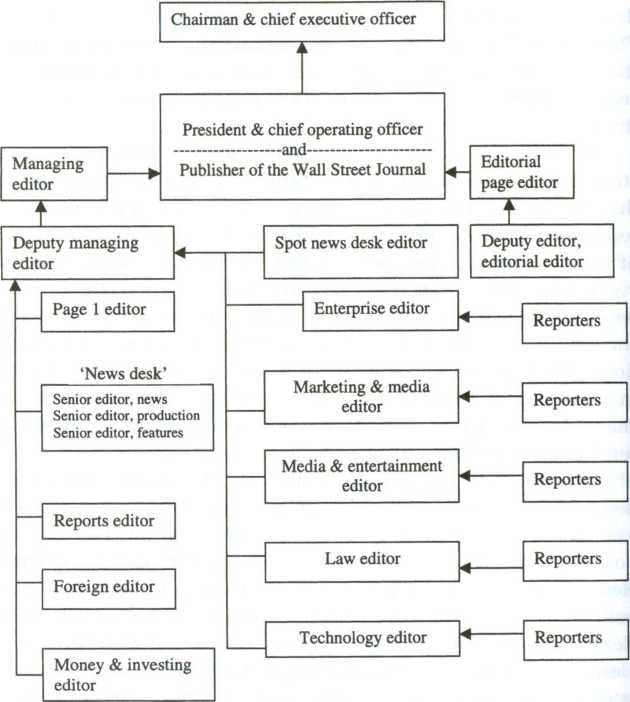
and Ruge's (1965) theory of gatekeeping, shows the classic "winnowing" process through which editorial content is developed. Gatekeepers at various points in the production process let some ideas through while barring others, resulting in what the editor considers to be all the news that is fit to print or, at least, fits (Shoemaker, 1991).
Holmes and Hundley (1997) further categorized conceptual and functional communication models into three types. The "action" model
Figure
7.7
Ericson, Baranak, and Chan's (1987) model of the news
production
process, presented by McQuail and Windahl (1993, p. 179), and
redrawn by the authors of this book
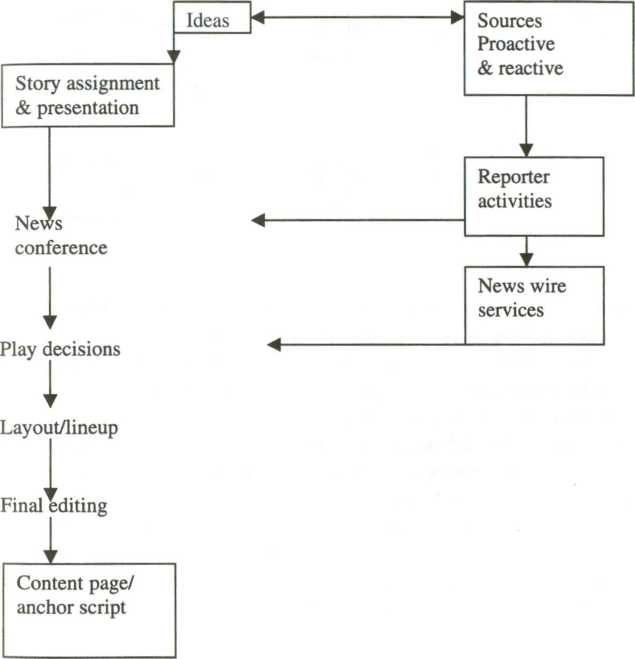
treats communication as "something that one person does to another" (p. 8). A variety of labels have been applied to such models, including the "conduit" model, the "injection" model, the "hypodermic needle" model, the "transmission" model, and the "linear" model. Because communication in the action model is unidirectional and unilateral, it resembles what psychologists refer to as the "stimulus-response" model. An example of an action model of communication is Shannon and Weaver's (1949) model based on information theory, mentioned earlier. In this model, the focus is upon the system's capacity to
Figure
7.8 Osgood's
(n.d.) model of communication with feedback, presented by Schramm
(1954, p. 24), and redrawn by the authors of this book
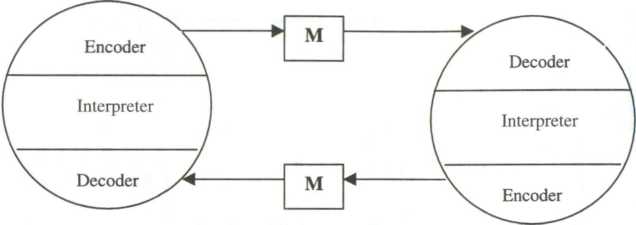
transmit the maximum amount of information successfully—that is, without unacceptable levels of distortion or "noise."
The "interactional" model builds upon the action model through the addition of feedback loops. Because they are more concerned about how humans communicate, Schramm's (1954) early models of communication add feedback as an important element in the process. Such models treat communication "as an alternating exchange of messages" (Holmes & Hundley, 1997, p. 9).
Figure 7.8 is an interactional model of communication originally proposed by Osgood in an unpublished paper and popularized by Schramm (1954, p. 24). Unlike the Shannon and Weaver (1949) model, this one treats message senders and receivers as essentially equivocal, with each party contributing to the sharing of meaning that occurs when communication takes place. Here, both parties encode messages: That is, they put their ideas—their mental images—into symbols they believe the other party will understand. The encoded message (m) is then decoded by the receiver: that is, translated from the symbols back into mental images. The process may be repeated until one or both parties tire of or are prevented from communicating, or both parties feel sufficiently satisfied that further communication is unnecessary.
Holmes and Hundley's (1997) third type of communication model, the "transactional model," was intended to overcome the one-directional nature of action models and the constraints of strictly alternating message exchanges found in interactional models. "The key differences... are simultaneity of encoding and decoding and fusing
Figure
7.9
Schramm's (195#p. 31) model of communication with fields of
experience, atoted by Severin and Tankard (2001, p. 59), and
redrawn byte authors of this book
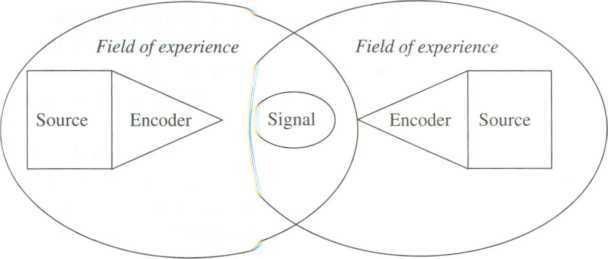
of sending/receiving activit»' (p. 10). Berko, Wolvin, and Wolvin's (1992) model of communicati® is an example, as are Schramm's (1954) later models of communicatfc, which include overlapping "fields of experience" as an important gredient in the communication process (Figure 7.9).
The notion of "fields ctexperience" is important because it reminds us that efficient coinunication can take place only to the extent that the parties involve! share certain basic experiences. If two people do not speak the samtlanguage, they may have a hard time decoding each other's messags. A newsroom that does not reflect demographically and cultural the diversity of its targeted audience may communicate poorly witbt least some segments of the audience.
Two points are worth maiig here, one fairly obvious, one not so obvious. We can see how prcfactive it can be to build upon earlier models by adding elements ad connections ignored previously but that we now consider impoartt. However, though one might be tempted to think that the transitional model is "better" than the interactional model, which is "bettffl than the action model, it is important to keep in mind the purpose for which the model was designed. Shannon and Weaver's (1949!simpler model of the communication process is better at capturing vdat these model builders were attempting to capture than other mode that added components irrelevant to Shannon and Weaver's concert Just because a model is more complicated than another, and just beause a model adds something that an earlier model is lacking, does not mean that it is necessarily an improvement. A model needs to be evaluated in terms of its purposes. As Hanneman (1988) noted, whereas one social scientist may be trying to create time- and space-invariant general laws of social behavior, another may be attempting to uncover and understand the "deep structure" of everyday life (p. 16). Because social scientists theorize about a remarkably diverse range of subjects, we should not be surprised to find an equally remarkable diversity in the kinds of models they employ.
In the study of communication, McQuail (1994) identified four distinct types of models, the first of which he called the "transmission" model. However, what McQuail considered to be a transmission model is not the same as what Holmes and Hundley (1997) meant by the same label. According to McQuail, a transmission model of communication is any model that treats communication as a process of the transmission of a fixed quantity of information—a message—that is determined by a sender or a source. Thus, the removal of unidirectional activity through the addition of feedback and the addition of simultaneous exchanges are not distinctions that make for a new type of model. Therefore, McQuail essentially ignored the distinctions made by Holmes and Hundley and lumped their three types of models together as transmission models. The Westley and MacLean (1957) model, which according to McQuail is perhaps the most complete and most highly regarded early version of a model of mass communication, is thus still a transmission model, even though it contains feedback. Holmes and Hundley (1997), in contrast, would label this an interactional model (Figure 7.10).
Regardless of whether one considers the Westley and MacLean (1957) model to be a transmission model or an interactional one, if we take the time to examine it, we will see what a well-formed and insightful model it is for describing the process of mass communication. First, events (xs) impinge on a person's (B) senses. Second, some events sensed by a communicator (A) are transmitted to the person, whereas others are not. This communicator is thus the "source" of some information the person receives. Third, some events are sensed by a special type of communicator, a "nonpurposive encoder (C) acting for B," such as a news reporter. Again, С transmits only some messages to the person. Finally, these sentinels (C) also receive information from sources (A), only some of which are transmitted to the person (B). By focusing on the "winnowing" process from the receiver's perspective, the Westley-MacLean
Figure 7.10 Westley and MacLean's (1957) model of communication,
adapted by Severin and Tankard (2001, p. 62), and redrawn by the authors of this book
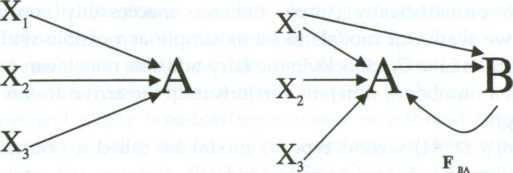
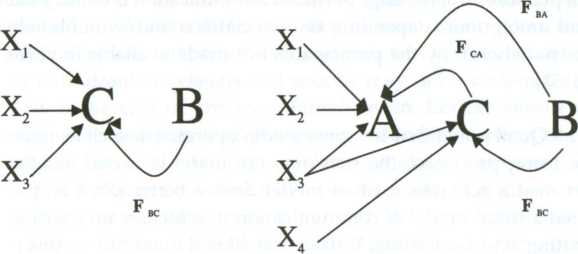
X = Message В = Receiver A= Source C= Journalist
model nicely complements the Ericson et al. (1987) model, which focuses on the process from the news gatherer's point of view.
At first glance, the Westley and MacLean (1957) model may appear to be quite intimidating because of its complexity. One of the authors well remembers when he first encountered this forbidding-looking model at the start of his graduate studies. After receiving a copy of the model in class, he turned to one of the other students in the seminar and whispered, "This looks like Custer's model of communication.
"Puzzled, the other student asked, "Custer's model of communication?" to which he replied, "Yes, just look at all those @#$%*& arrows."
Such irreverence notwithstanding, this anecdote points to the problem of attempting to construct a model that, for our purpose, is neither too unrealistically simple nor too inaccessibly complex. Generally, we want our models to be as simple as possible without being too crude. Like Goldilocks in the fairy tale, this may mean going to bed with a number of different versions until we arrive at one that feels just right.
McQuail's (1994) second type of model he called a "ritual" or "expressive" model. According to McQuail:
Ritual or expressive communication depends on shared understandings and emotions. It is celebratory, consummatory (an end in itself) and decorative rather than utilitarian.... Communication is engaged in for the pleasures of reception as much as for any useful purpose. The message of ritual communication is usually latent and ambiguous, depending on associations and symbols which are not chosen by the participants but made available in culture.
(p. 51)
McQuail noted that for some media operations, such as news and advertising processes, the transmission model is useful but that for other media activities a ritual model does a better job. Carey (1975) offered a ritual model of communication that focuses on sharing, participating, and associating. What is considered important in this model is not "the extension of messages in space but the maintenance of society in time; not the act of imparting information but the representation of shared beliefs" (McQuail, 1994, p. 51). Another example is McQuail and Windahl's (1993) "Christmas spruce model of ritual communication" (p. 55), which consists simply of the iconic image of a tree decorated for the holidays. "In one culture at least, it symbolizes ideas and values shared and understood albeit vaguely and variously. There is clearly no instrumental purpose" (p. 55). A ritual model of communication also might describe communication that occurs during times of crisis, when the form of communication may be more important than its content and when communication may be distinguished more by its uniformity ("We stand united") than by anything else.
McQuail called his third type of communication model a "publicity" model. McQuail noted that often the primary aim of mass media is neither to transmit particular information nor to unite a public in some expression of culture, belief, or values, but simply to catch and hold people's attention. In doing so, the media attain one direct economic goal, which is to gain audience revenue, and an indirect one, which is to sell audience attention to advertisers. One might say that the primary goal of some forms of communication is to sell eyeballs.
A publicity model can be useful when comparing the performances of different types of media systems, such as commercial television and public broadcasting stations, or national media systems that predominate in the use of one or the other of these types of media systems. For example, the United States has a predominantly commercial-based broadcasting system in which success is measured primarily in terms of audience size, whereas the Netherlands has a predominantly public-based system in which capturing a large audience is relatively less important. This means that in the United States much attention is given to finding efficient ways to grab the audience's attention. However, in the study of news programming formats and content, it is known that factors that increase attention can simultaneously decrease comprehension, and vice versa. Thus, sets of brief stories with dramatic visuals and sounds may draw audience attention but at the cost of greater comprehension. Longer stories with "talking heads" and less vivid pictures and sounds may improve comprehension but at the expense of losing audience attention. This means that media systems that seek to increase attention to their news products may at the same time inadvertently decrease comprehension of their news products. A national media system built upon a publicity model of communication may relegate the importance of audience comprehension behind that of getting a large share of the audience. A comprehensive comparison of attention and comprehension factors in news broadcasts in the United States and the Netherlands shows that these two national broadcasting systems do differ markedly in how they present the news. The publicity model of communication helps show why they differ (Klijn, 1998).
McQuail's fourth model of communication is called a "reception" model. The focus of this model is on the receiver and the power of the audience in giving meaning to messages. In this model, all messages are considered "polysemic": that is, possessing multiple meanings. The context and the culture of the receiver dictate the meaning the message will have. Hall (1980), for example, showed the stages of transformation through which a media message passes on the way from its origins to its reception and finally to its interpretation. Arrows with broken lines can be used to indicate that audience members have the ability to "read between the lines" and can even reverse and subvert the intended direction of the message (Figure 7.11).
This reception model presents unique challenges to the social scientist who must grapple with the many possible readings, including oppositional ones, that an audience can give to a message. For example, an executive of the U.S. automobile giant General Motors once proclaimed that what is good for General Motors is good for the country, a comment that became a catch-phrase in the debate over corporate power in America. This occurred while the company's Chevrolet division was running a long-standing advertising campaign with the slogan "See the U.S.A. in your Chevrolet." Though it appears that few receivers of this advertising slogan saw a connection between it and the other catch-phrase, some did, and the "message" they received encouraged them not to purchase a Chevrolet but to do the very opposite. As McQuail (1994) noted,
The essence of the "reception approach" is to locate the attribution and construction of meaning (derived from the media) with the receiver.... While early effects research recognized the fact of selective perception, this was seen as a limitation on, or a condition of, the transmission model, rather than part of a quite different perspective, (pp. 53-54)
REPRESENTING THEORIES IN MODEL FORM
As models become more complicated (e.g., as they add more parts and connections in an effort to cover more territory or to delve more deeply into territory already covered) and as they become more dynamic (e.g., as they add more moving parts and connections in an effort to show change or the possibility of change), they become more difficult to depict. Holmes and Hundley (1997) reviewed mass communication texts on this point and found that in those that compare the action, interactional, and transactional models of communication, "the transaction model is identified in these textbooks as the best, most complete, and most accurate" (p. 11). At the same time, they said, "The authors of these texts also describe the transactional model as the most difficult to visualize" (p. 11).
Figure
7.11 Hall's
(1980) reception model of communication, presented by McQuail and
Windahl (1993, p. 147), and redrawn by the authors of this book
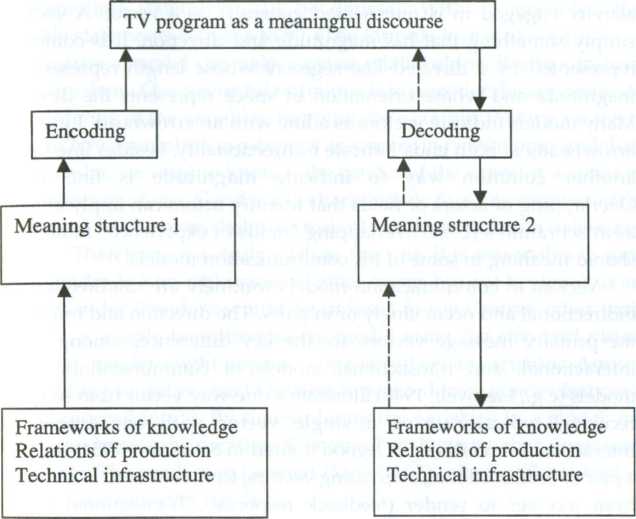
Adler and Towne (1990) suggested that model builders may become dissatisfied with two- and three-dimensional static representations and that "an animated version in which environments, communicators, and messages constantly change would be an even better way of capturing the process" (p. 15). Advancements in computer and communication technologies soon may make such ideas more practical. As Holmes and Hundley (1997) have stated, "Representing a process entails visualizing a story" (p. 12). The crucial point is to have a good story to tell, for then considerable effort may be worth putting into the visualizing of it. On the other hand, as Kaplan (1964b) suggested, a beautiful model may be momentarily distracting, but if underneath the glitter there is not much substance we tire and move on.
Models in the social sciences tend to follow certain general conventions, what Kress and van Leeuwen (1996) called the "grammar of visual design." Holmes and Hundley (1997) noted that although this grammar is incomplete, it reveals "a surprisingly complex set of conventions governing the production of meaning" (p. 19). Models contain objects, which include participants (actors) and goals (actions). The activity engaged in is represented generally as a vector. A vector is simply something that has magnitude and direction. It is commonly represented by a directed line segment whose length represents the magnitude and whose orientation in space represents the direction. Many models indicate vectors as a line with an arrowhead. Lines with arrowheads at both ends indicate bidirectionality. Besides line length, another common way to indicate magnitude is line width. Overlapping of actors or fields that identify actors can imply a vector, as in Schramm's (1954) overlapping "fields of experience" to illustrate shared meaning in some of his communication models.
Vectors in communication models routinely are unidirectional or bidirectional and occur singly or in pairs. The direction and number of the primary message vectors are the key differences among action, interactional, and transactional models of communication. Action models (e.g., Lasswell, 1948) illustrate a one-way vector from sender to receiver, typically using a single vector with one arrowhead. Interactional models (e.g., Osgood's, cited in Schramm, 1954) illustrate a pair of unidirectional, alternating vectors, from sender to receiver and from receiver to sender (feedback response). Transactional models (e.g., Ericson et al., 1987) illustrate simultaneous bidirectionality with arrowheads at both ends of a vector.
DERIVING THEORETICAL STATEMENTS FROM MODELS
As we have seen, a model can help a scientist stay focused by highlighting those parts of a system and the connections among them that the scientist thinks are most relevant and most worthy of study. A model also can help a scientist communicate to others the parts and connections of a system considered most relevant. For the theory builder, a model also can suggest new theoretical statements. It is this last use of models that we discuss here.
As we noted earlier, when a scientist is interested in explaining how something works or in predicting the outcome of a process, he or she often begins simply, perhaps with one independent variable believed to influence one dependent variable. Often, however, the scientist begins to think about how other variables might be involved. As more variables are brought into the picture, the number of possibilities as to how they can be combined greatly increases. For example, if we consider all the possible bivariate combinations with 5 variables, 20 theoretical statements can be derived. With 10 variables, the possible statements increase to 90. (The formula is (n x n) - n.)
Because a model can help suggest relationships, it also can help eliminate them. One powerful technique is to consider the approximate time ordering of the variables. Suppose, for example, that we are interested in how journalists use experts as sources in news stories and that, in particular, we want to know if the gender of the expert is a factor in the frequency of use. Gender is a characteristic that one receives early in life, and for the overwhelming majority of the population it does not change. Therefore, in a study such as this one, it is reasonable to consider gender as a possible cause of other events but not to view it as an effect. Gender therefore would be ordered in time before other variables. In a simple two-dimensional model using the standard visual grammar, gender might appear to the left of other variables. Arrows representing causation might be seen to proceed from gender, but none would proceed into it. By time-ordering the variables in a model, we eliminate from consideration theoretical statements that contradict that order. The result may be what Hage (1972) called a "flow chart of theoretical statements" (p. 56).
Working with a model in this way also may help us recognize subsets of variables that, in effect, represent chains of causes or effects. For example, as we examine our model we may recognize that variables fall into classes or types. We may be able to "bundle" these. Suppose, for example, that we are studying social control in a newsroom. We may be interested in some variables that are outside the newsroom. Other variables may represent newsroom structures, and still others may represent newsroom resources, newsroom outputs, and so forth. We may find not only that variables cluster into classes but that there is a time ordering to these blocks, and it may therefore be possible to establish a unidirectional flow.
Once this has been done, the next step may be to consider feedback. Variables and subsets of variables that move in the opposite direction of the established flow may produce important feedback effects that should not be ignored if one hopes to approximate reality. In the case of social control in the newsroom, for example, the extent to which management hears and addresses the concerns of workers may or may not affect the operation of the system. As Hage (1972) noted of the model-building process, "This may sound like an impossible task, but once variables are written down on a piece of paper or a blackboard, theoretical statements connecting them should quickly come to mind. Finding the variables has always been the harder task" (pp. 57-58).
What we have been describing here is essentially a form of path analysis, using a model as a guide. The product of our analysis—the theoretical statements we derive—will be only as good as the model. If the map is poor, it may lead us into quicksand or over a cliff. To put it in the parlance of computers, "garbage in, garbage out." Computers can easily generate complex path models, but computers cannot easily evaluate them. Scientists may be interested in whether one concept is connected with another, but they usually are interested in more than that. They are interested in causes and consequences.
A productive method for addressing the question of causes and effects is to examine several related case studies. Take a variety of situations from different times and places so that general theoretical statements are derived. Suppose, for example, that we are interested in the role of the mass media in the successful overthrow of national leaders. We might select the Marcos regime in the Philippines, the French Revolution, the Spanish Civil War, Watergate in the United States, the collapse of Czarist Russia or the Soviet Union, and any of a number of other diverse cases that might differ in terms of location, time period, length, violence, and other important variables. The next step is to select these same places at times of relative stability: that is, cases in which the phenomenon exists or predominates and others in which it does not exist or is modest. Thus, we observe the Philippines or France 5 or 100 years earlier or later. We then look for commonalties across the selected cases. We look not only for the presence of factors during times of crisis but for the absence of these same factors during times of stability, and vice versa. How do the media behave across these different times and places? What are the similarities, the differences? Does the role of the media change before, during, and after a coup, and, if so, how? What patterns do we recognize? At this point, some readers might say, "This seems like an awful lot of trouble to go through just to derive interesting theoretical statements." This is true. Constructing productive models and deriving from them interesting theoretical statements is, alas, an awful lot of trouble. On the other hand, building on existing models can be much less daunting and may be a good way to get one's feet wet.BUILDING ON EXISTING MODELS
Suppose one wants to model cultivation theory (Gerbner & Gross, 1976). This theory holds that television possesses properties that make it an especially powerful influence, such as its relatively high penetration rate (the percentage of the population watching) and saturation rate (the percentage of time people spend watching). Additionally, the theory maintains, the "TV world" varies systematically from the "real world," transmitting constant and consonant moral messages about risk and power. The result, the theory proposes, is that viewers think that the world is scarier than it really is. Thus, for example, heavy viewers have a greater fear of crime.
Because cultivation is a communication process or, more precisely, a mass communication process, we should be able to relate it to any general model of communication, such as the barriers, Shannon and Weaver (1949), or Westley and MacLean (1957) models. However, because any model focuses selectively on a process's elements and connections, we should expect some models to relate better than others to a particular theory.
Consider, for example, how well the Lasswell (1948) model describes the cultivation process. This model begins with a source saying something. It therefore does not focus our attention on important aspects of the cultivation process that deal with why someone says something. At the same time, Lasswell's model draws attention to the channel, whereas cultivation almost ignores channel factors, treating the channel more like a constant than a variable.
Years before Gerbner and Gross (1976) proposed their theory of cultivation, Braddock (1958) suggested that Lasswell's model be expanded to consider two important elements it ignores. He proposed that in addition to Lasswell's five questions to describe an act of communication, two questions be asked: (a) For what purpose? and (b) Under what circumstances? Braddock argued that a fuller understanding of the process of communication results when we consider both the sender's intention in sending a message and the circumstances under which the message is constructed and transmitted.
Braddock's expanded model does a better job of relating to the cultivation process than does Lasswell's (1948) original model. Again, this should not be viewed as a criticism of Lasswell's model; the purpose of his model was not to depict cultivation per se. There is a certain appeal in being able to consider an act of communication as an isolated event.Nonetheless, there also is a certain appeal to the idea that an act of communication does not really begin with someone saying something but that there are forces at work that lead someone to say something. This latter idea is certainly relevant to the cultivation process, if not to the communication process generally. If we are willing to assume that an act of communication does not occur in a vacuum and that the conditions leading to an utterance are important to consider, then it is possible to expand the Lasswell model in other provocative ways as well. We might, for example, include the idea that reality (the "real world") is viewed through the filter of one's culture (e.g., the "TV world") and that this cultural filtration influences what gets said, or the idea that communication is not linear but cyclical, as in Osgood's model including feedback (cited in Schramm, 1954). If one ignores the italicized terms, Figure 7.12 is an example of a general model of communication that incorporates these ideas. The italicized terms change the figure into a model of the cultivation process. More recent advancements to that theory (e.g., mainstreaming and resonance) could be incorporated into this model as well.
Modifying an existing model to suit one's needs is a tried and true method for advancing science. A review of the models presented here will show the extent to which many have adapted elements of earlier ones. Given that they often are attempting to model the same general process, this should not be surprising. Furthermore, because models are by definition selective, even a slight change tends to have important implications. For example, DeFleur (1970) may have made only one major modification to the Shannon and Weaver (1949) model— adding feedback—but it represented a critical change.
By considering how well existing models represent new theories or theoretical developments, and by modifying these models to create more precise representations, the model builder can help others see more clearly commonalities across theories, how one theory fits into general models, how theoretical advancements make sense in terms of previous models, and other important aspects of theory building.
DEVELOPMENTS IN MODEL BUILDING
Because models are designed to clarify new theories and theoretical hunches, we should expect models to reflect the theoretical interests of the day. Thus, when theories at one time tend to focus upon certain
Figure 7.12 Lasorsa's expanded model of Gerbner and Gross’s (1976) cultivation process, original to this book
In
the world

With what effect (DESTINATION) Social control
I
To whom (AUDIENCE)
Public
A s
we know it (CULTURE)
s
we know it (CULTURE)
Social reality
![]()
 ho
says (SOURCE) Ideology
ho
says (SOURCE) Ideology
